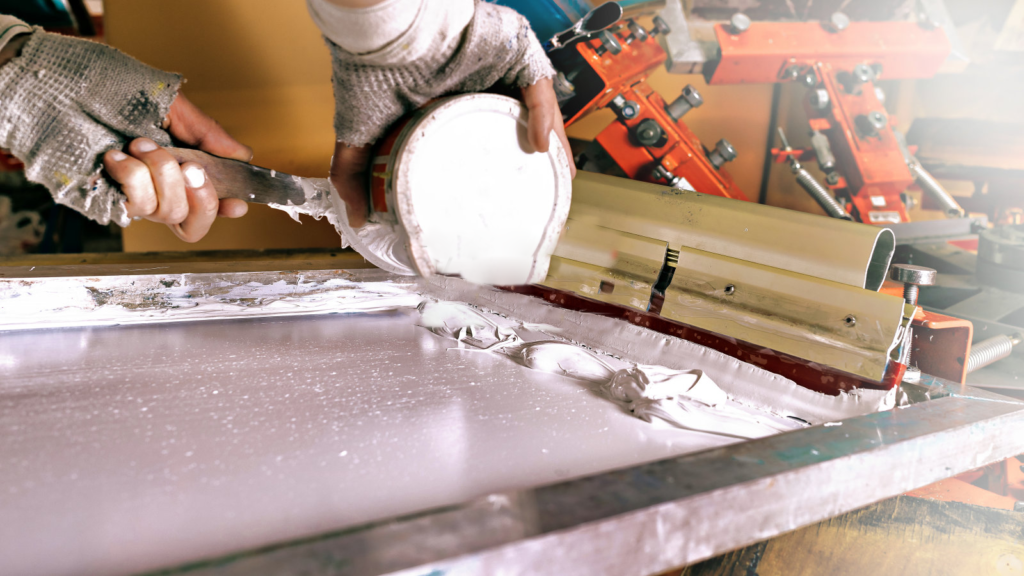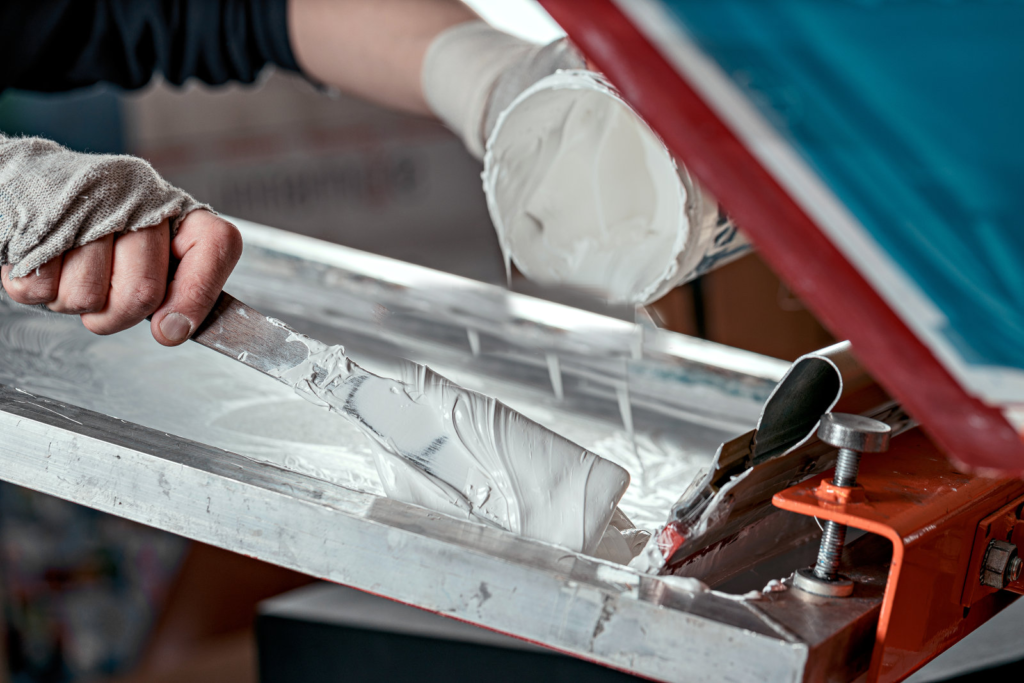
How to Clean Plastisol Ink Off Screens: An In-Depth Guide for Screen Printers
Introduction: Mastering the removal of ink for screen printing is essential for any screen printer. Mistakes are common in screen printing, and knowing how to effectively clean screens without causing damage can save both resources and time. In this guide, we’ll explore the most effective techniques, from chemical solutions to eco-friendly options, and how to maintain the best results with plastisol inks.
1. Understanding Plastisol Ink and Screen Printing Techniques
- What is Plastisol Ink? Plastisol ink, a widely used medium in screen printing, offers vibrant colors and durability. Unlike water-based inks, plastisol inks don’t dry in the screen, allowing flexibility in application but presenting unique challenges for removal.
- Characteristics of Ink for Screen Printing: Discussing the heat-curing properties of plastisol screen printing ink, why it adheres strongly to screens, and the challenges in removing it post-use.
- Why Screen Cleaning is Crucial: Proper cleaning of screen printing ink plastisol is essential for high-quality prints, avoiding ghost images, and ensuring longevity of the screen’s surface.
2. Key Reasons for Removing Plastisol Ink from Screens
- Preserving Screen Longevity: Regular cleaning prevents buildup, which can impact the quality of future prints and extend the screen’s life.
- Preventing Design Overlap: Residual screen print ink can interfere with new designs, especially in detailed prints.
- Cost Efficiency in Corrections: Cleaning allows for reusing screens and correcting errors efficiently without needing a replacement.
3. Popular Methods for Removing Ink for Screen Printing from Screens
- Safety Precautions: Before starting, ensure adequate ventilation, wear gloves, and use eye protection to prevent exposure to fumes.
3.1 Plastisol Ink Remover Solutions
- Application Process: Plastisol remover solutions are designed to dissolve plastisol screen printing ink. Use a soft cloth to apply the remover, allow it to soak, and then rinse the screen thoroughly with cold water.
- Tips for Effective Use: Techniques for applying remover with a brush for stubborn areas, leaving no trace of screen printing paint or ink residue.
- Why Plastisol Remover is Effective: Specifically designed for plastisol-based ink for screen printing, making it one of the most effective removal methods available.
3.2 Nail Polish Remover (Acetone) Technique
- How Acetone Works on Ink for Screen Printing: Acetone can dissolve screen printing inks effectively, particularly on small design areas or mistakes.
- Limitations and Cautions: Acetone may damage synthetic fabrics or delicate screen materials, so it’s best to test a small area first.
3.3 Using Spotting Fluid with a Spray Gun
- How a Spotting Gun Works: A spotting fluid gun sprays the fluid onto the back of the design, dissolving ink for screen printing without direct contact.
- Costs and Benefits: While more costly, it’s an efficient solution for larger operations with frequent corrections.
4. Eco-Friendly and Abrasive Techniques for Removing Screen Printing Ink
- Natural Abrasives like Sugar Scrubs: Applying sugar with light pressure acts as an abrasive for removing screen print ink while being gentle on the screen.
- Limitations of Abrasive Methods: Avoid overuse of abrasives on screens with fine mesh to prevent damage.
4.1 Iron and Peel Method
- Iron and Paper Bag Method: This method applies heat, causing the screen printing ink plastisol to lift onto the paper bag, which is then peeled away.
- When Heat is Beneficial: This technique works well for small designs or stubborn areas but should be used sparingly.
5. Essential Cleaning Tools for Efficient Ink Removal
- Squeegees and Soft Brushes: Soft brushes are ideal for delicate screens and help in the detailed cleaning of ink for screen printing.
- Non-Abrasive Pads: Non-abrasive pads can clean plastisol print residue without scratching screen surfaces.
- Lint-Free Cloths for Finishing: Use lint-free cloths to wipe off excess ink without leaving fibers that could interfere with future prints.
6. Preventive Maintenance for Longevity of Screens
- Establishing a Cleaning Routine: Consistent cleaning reduces ink buildup, making each cleaning session easier and extending screen life.
- Using Eco-Friendly Products: Eco-friendly screen printing inks and cleaners are safer for the environment and reduce long-term chemical exposure.
- Storing Screens Properly: Tips for screen storage to prevent dust or residual ink from sticking and hardening on the screen’s surface.
6.1 Routine Inspection and Damage Prevention
- Inspecting for Residue: Checking screens for leftover ink for screen printing to prevent ghosting.
- Avoid Over-Scrubbing: Using gentle motions to avoid weakening the screen’s structure.
7. Eco-Friendly Alternatives for Ink Removal

- Eco-Friendly Plastisol Cleaners: Some companies produce non-toxic, eco-safe removers for plastisol screen printing ink.
- Minimizing Chemical Waste: Proper disposal and recycling protocols to protect the environment.
7.1 Sugar Scrub as an Alternative
- How it Works: Gently scrubbing sugar onto the design helps remove screen print ink. It’s safe, natural, and reduces reliance on chemicals.
8. Frequently Asked Questions on Cleaning Plastisol Ink
- Can I Use Household Detergent? While household detergent may help remove ink residue, it’s not as effective on plastisol inks and should be followed with a specialized cleaner.
- How Often Should I Clean My Screen? For optimal results, clean the screen after every print job to prevent ink buildup and ensure a clean printing surface.
- What if Ink Stains Remain After Cleaning? Residual screen printing ink plastisol can often be removed by repeating the cleaning process or using a stronger remover.
9. Advanced Tips for Maintaining Clean Screens in a Screen Printing Business
- Professional Techniques for Efficient Cleaning: Explore additional tools, like high-pressure washers, that can efficiently clear residual ink for screen printing.
- Designate a Cleaning Area: Set up a dedicated area for screen cleaning with all necessary tools and materials for a streamlined process.
- Training Staff on Cleaning Best Practices: Educating team members on effective ink for screen printing removal methods ensures consistency and quality across all printed products.
Conclusion: Keep Screens Clean and Ready for High-Quality Prints
- Benefits of Regular Screen Cleaning: Prevents ink buildup, enhances print quality, and extends screen lifespan. Using the right techniques and products for ink for screen printing removal will help any screen printing business maintain high standards.
- Continued Learning and Practice: Each screen may react differently based on materials used, so experimenting with various cleaning methods on test screens can be invaluable.


